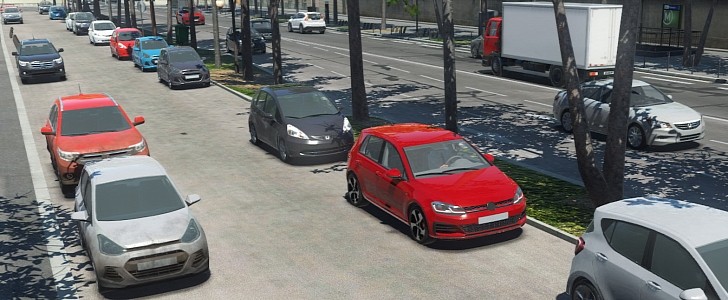In order to help accelerate the development of complex driving systems, automotive sim experts rFpro and hardware specialists Xylon are working to interface real hardware with virtual environments for both open and closed-loop testing.
Right now, they’re focusing on obtaining a new level of realism, by exchanging the software ECU model with a real physical ECU, stimulated and monitored from the software simulator. This, in turn, can lead to products being ready for market in the fastest and most cost-effective ways.
The two companies have been working on an interface concept, mixing rFpro’s driving sim software with Xylon’s 360-degree Surround View parking assistance ECU. When deployed in the real world, this system stitches together the output from four cameras positioned around the vehicle – front grille, rear bumper, plus under each door mirror. In turn, these cameras create a bird’s eye view of the vehicle and its surroundings.
“rFpro has been the leader in high-definition and high-quality world models for real-time simulators for many years, and that makes this expansion into hardware-in-the-loop (HIL) injection systems a natural progression,” said company operations director, Matt Daley.
“The ability to interface with third-party hardware providers such as Xylon is a key advantage of our flexible approach, and ensures customers are not locked in to any one solution. Working together has enabled us to bring advancements in hardware-in-the-loop simulations to our customers.”
Inside the simulation, rFpro’s high-definition scenes are rendered using models that match the characteristics of each parking camera, including having that fish-eye lens distortion. The output is then processed by Xylon’s logiRECORDER interface box, before being converted into four video feeds that eventually make their way to the hardware ECU.
In the end, the ECU is being fed data that is said to be indistinguishable from that generated in the real world, which then allows engineers to test a wide variety of scenarios using production firmware.
As previously stated, closed-loop testing can also take place by having the ECU’s responses being fed back through the interface box, allowing it, in turn, to respond and update the simulation based on the ECU’s reactions.
The two companies have been working on an interface concept, mixing rFpro’s driving sim software with Xylon’s 360-degree Surround View parking assistance ECU. When deployed in the real world, this system stitches together the output from four cameras positioned around the vehicle – front grille, rear bumper, plus under each door mirror. In turn, these cameras create a bird’s eye view of the vehicle and its surroundings.
“rFpro has been the leader in high-definition and high-quality world models for real-time simulators for many years, and that makes this expansion into hardware-in-the-loop (HIL) injection systems a natural progression,” said company operations director, Matt Daley.
“The ability to interface with third-party hardware providers such as Xylon is a key advantage of our flexible approach, and ensures customers are not locked in to any one solution. Working together has enabled us to bring advancements in hardware-in-the-loop simulations to our customers.”
Inside the simulation, rFpro’s high-definition scenes are rendered using models that match the characteristics of each parking camera, including having that fish-eye lens distortion. The output is then processed by Xylon’s logiRECORDER interface box, before being converted into four video feeds that eventually make their way to the hardware ECU.
In the end, the ECU is being fed data that is said to be indistinguishable from that generated in the real world, which then allows engineers to test a wide variety of scenarios using production firmware.
As previously stated, closed-loop testing can also take place by having the ECU’s responses being fed back through the interface box, allowing it, in turn, to respond and update the simulation based on the ECU’s reactions.






